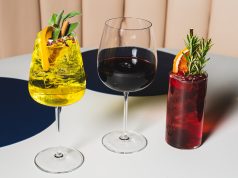
One glass of cabernet sauvignon was described as “powerful and heavy.” Another was described as “subtle and refined.” The only difference? The music that was playing while people drank the wine.
A few years ago, Adrian North, a psychology professor at Heriot-Watt University in Scotland, tested the impact of music on taste perception by pouring wine for 250 students. Some tasted the wine while listening to music identified by others as “powerful and heavy,” while others listened to music that was “subtle and refined,” “zingy and refreshing” or “mellow and soft.” Other students drank without any music. After enjoying their wine for five minutes, the students were asked to rate how much the wine tasted like the musical descriptions.
The conclusion, as put simply in the British Journal of Psychology: “Background music influences the taste of wine.”
When North’s study came out, oenophiles were infuriated. Here was yet another academic calling wine appreciation into question.
Rest easy, wine lovers. Perception is easily fooled.
Widespread derision of wine criticism began in 2001 when Frédéric Brochet, a University of Bordeaux psychologist, poured one glass of red wine and one glass of white wine for 54 oenology students — and then asked them to describe each wine in detail. Students described each wine with the laundry list of descriptors one would expect for reds and whites. What Brochet didn’t tell the students? Both wines were the same. The white in one glass was simply dyed red.
Ever since, the media has jumped at any opportunity to call baloney on oenophilia. But psychologists have long known that humans are easily tricked, especially when relying on taste buds.
Consider a 2012 study from Cornell University’s Food and Brand Lab. By giving an extreme makeover to a Hardee’s, researchers discovered that people will eat less but enjoy their food more when at a fine-dining establishment instead of a fast-food joint. A 2006 study led by John Bohannon, a biologist and science journalist at Harvard University, found that most people can’t distinguish pâté from dog food.
Does this mean that Michelinstarred restaurants should replace pâté with Purina Puppy Chow and start serving Hardee’s Patty Meltdowns? Of course not.
Expectations matter. Heck, confirmation bias dictates that expensive wines taste, well, expensive. And food, like wine, is unpredictable. But please hold the Puppy Chow; I’d rather eat pâté. And if I’m dropping serious coin on dinner, I hope it’s prepared by a Michelin-starred chef and not a Hardee’s line cook. I’m confident in my palate, but I’m also confident enough to admit that sometimes, I’m wrong.
Plenty of people have dedicated their lives to wine — producing it, serving it, studying it, selling it. Plenty more simply enjoy wine and have opinions on what they drink. Sure, some people are particularly gifted tasters. But wine appreciation is a subjective pursuit for everyone who imbibes. And just as it’s perfectly valid for a moviegoer to proclaim her preference for Batman over Birdman, it’s perfectly valid for a wine enthusiast to proclaim his preference for a light-bodied Syrah from St. Joseph in France over a weighty Shiraz from Coonawarra in Australia.
Misleading a wine connoisseur by filling an empty bottle of First Growth Bordeaux with Two Buck Chuck might be fun, especially if he’s insufferable. But it only proves that humans are fallible and easily tricked, especially when an environment has been manipulated. That’s nothing to worry about.
Respond: [email protected].
David White is the founder and editor of Terroirist.com, which was named “Best Overall Wine Blog” at the 2013 Wine Blog Awards.














